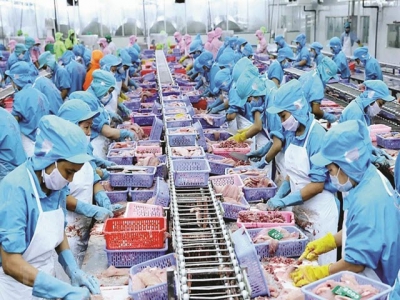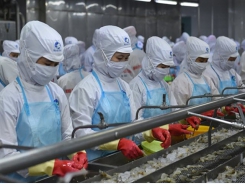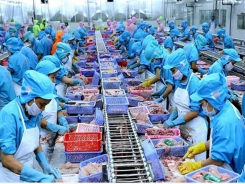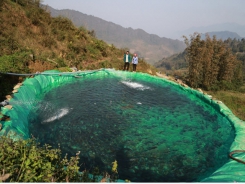Exports of frozen goods are leading

After a serious decline in the first two months of the year, in the future, seafood exports are expected to continue facing many difficulties due to the impact of Covid-19. Notably, the trend of seafood consumption has changed significantly, moving from fresh goods to frozen goods.
Seafood export will continue to face many difficulties due to Covid-19. Photo: ST.
Value reduced by nearly 16%
According to the Vietnam Department of Seafood Processing and Development (MARD),in the first two months of this year, seafood export reached USD 932 million, down to 15.9%compared to the same period in 2019. Japan, the United States, Korea and China are the top four import markets of Vietnam's seafood in the first month of 2020, accounting for 54.9%of total export value.
The Covid-19 epidemic has a great impact on the export of agricultural products in Vietnam. Seafood exports to all markets decreased sharply over the same period last year, in which the market with the strongest drop in export value was China. Specifically, seafood export turnover to Japan accounted for 18.02%of total export turnover, down 28.16% over the same period in 2019; The US accounted for 17.62%, down 26.34%; South Korea accounted for 10.27%, down 31.53%; China accounted for 8.94%, down to 43.48%.
The Ministry of Agriculture and Rural Development estimates that in the future, the agriculture and fisheries sector will face many difficulties, typically the impacts of climate change that appear from the beginning of the year, causing drought and saltwater intrusion in the Mekong Delta,affecting aquaculture. In addition, the "yellow card" for seafood exports issued by the European Commission (EC) has not been removed.
Beside the gloomy period, according to the Ministry of Agriculture and Rural Development, factors such as weather atsea is relatively favorable, fuel prices fall; preferences of the Comprehensive and Progressive Agreement for Tran-Pacific Partnership (CPTTP) and Vietnam-EU FTA (EVFTA); anti-dumping tax rates on the US market decreased; equivalent accreditation results of the food safety management and control system on Pangasius and catfish products (Silurifomes) announced by the US Department of Agriculture is a favorable basis for fishery products of Vietnam to become more competitive.
With the EVFTA, which is expected to come into effect in July 2020, the Ministry of Agriculture and Rural Development further emphasizes thatthis FTA opens up great opportunities for Vietnam's seafood exports to the EU. As committed in theagreement, when EVFTA comes into effect, about 840 basic tariff lines, accounting for about 50% of the tariff lines for fishery products will be reduced to 0%; the rest have a roadmap to cut down from three to seven years.
Priority for using frozen goods
The Import-Export Department (Ministry of Industry and Trade) said thatthe Covid-19 epidemic is spreading to many countries aroundthe world, including many major seafood export markets of Vietnam such as South Korea and Italy. This will have aimpact on the prospects of seafood exports in the future. Notably, there will be changes in consumption and import trends in markets affected by the Covid-19 epidemic. Specifically, importing frozen seafoodis moreconvenient and easier to process at home than fresh seafood. Canned seafood products will also be popular.
From the perspective of representatives of exporting enterprises, especially the export of key catfish products, Mr. Duong Nghia Quoc, President of Vietnam Pangasius Association said it is unknown when the Covid-19 outbreak in China and currently happening in many countries will end. The impact of this disease on seafood export activities to China is quite clear. I suggest that the Government and the State Bank of Vietnam soon take measures to support policies, loans, interest rates for businesses. Thus, the new businesses can be assured of production and overcome economic difficulties during the pandemic.
Up to now, the whole seafood industry has had a common goal for 2020 to strive to reach the total output of 8.5 million tons of aquatic products andexport value of fishery products ofabout USD 10 billion. The representative of the Ministry of Agriculture and Rural Development said that in the future, the whole sector will focus on developing aquaculture of key items(black tiger shrimp, white leg shrimp, catfish) and those of high economic value in the direction of enhancingcommercial value and sustainable development; monitor and firmly grasp the situation, weather changes and information on aquatic resources to promptly guide and mobilize boats to produce suitable jobs for efficient exploitation. The Ministry of Agriculture and Rural Development will also direct localities to guide fishermen in promoting the application of scientific and technical advances, organizing exploitation in groups, saving cost of moving fishing grounds, and raising exploitation efficiency; studying and proposing construction to submit to the Prime Minister for approval a comprehensive program to ensure safety for people and fishing vessels engaged in fishery activities.
"Develop a full process of certifying fishery products before exporting; coordinating to complete the electronic certification system to connect the fishery database system such as fishing permits with the certification of fishing stocks; guide, urge and inspect the implementation of the inspection and control process of fishing vessels, the volume of loading and unloading through the port as required by the EC, prepare the content to work with the EC Inspection Delegation to conduct progress. The implementation of the 2nd recommendations (at the end of May) is also an important issue in the future,”Mr. Tran Dinh Luan, Director General of the General Department of Fisheries (MARD) said.
Có thể bạn quan tâm
Phần mềm

Phối trộn thức ăn chăn nuôi

Pha dung dịch thủy canh

Định mức cho tôm ăn

Phối trộn phân bón NPK

Xác định tỷ lệ tôm sống

Chuyển đổi đơn vị phân bón

Xác định công suất sục khí

Chuyển đổi đơn vị tôm

Tính diện tích nhà kính

Tính thể tích ao hồ




 Viet Nam shrimp segment above water
Viet Nam shrimp segment above water  Sa Pa salmon farmers hit by pandemic
Sa Pa salmon farmers hit by pandemic